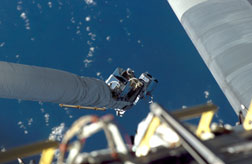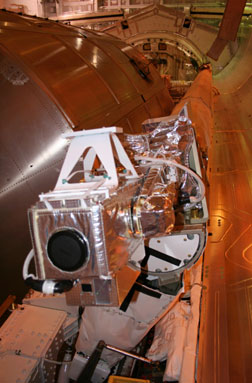NEWS RELEASES
FOR IMMEDIATE RELEASE
August 17, 2005
Sandia assists NASA with several shuttle projects
Sandia-created sensor finds loose gap filler on Discovery
 Sandia’s orbiter inspection sensor, attached
to the space shuttle Discovery’s robotic arm, characterized
loose gap fillers. (NASA photograph)
Sandia’s orbiter inspection sensor, attached
to the space shuttle Discovery’s robotic arm, characterized
loose gap fillers. (NASA photograph)Download 300dpi JPEG image, “Arm-with-scanner.jpg,” 644K (Media are welcome to download/publish this image with related news stories.)
ALBUQUERQUE, N.M. — Several Sandia National Laboratories projects were instrumental in helping NASA with its Space Shuttle Discovery’s return-to-flight mission (STS-114).
Projects ranged from creating an orbiter inspection sensor to analyzing sensors placed on the orbiter’s wing-leading edges to providing peer review reports. Sandia also studied the vibrations caused during the rollout of the space vehicle, and developed an ultrasonic nondestructive inspection method.
Sandia was instrumental in analyzing the cause of the accident that destroyed the Columbia during reentry in Feb. 1, 2003. A Labs-wide team effort helped confirm that the accident was caused by foam from the external tank that impacted the wing leading edge on takeoff.
The following is a summary of Sandia projects contributing to STS-114:
Orbiter inspection sensor
Sandia provided the primary Thermal Protection System (TPS)
inspection sensor to NASA for the mission.
Sandia engineers Bob Habbit and Bob Nellums led a collaborative effort of nearly 120 Sandia employees in creating the sensor.
Using 3-D imaging, the sensor inspects the orbiter for critical damage during the mission and alerts astronauts if further investigations are needed to repair the damage. The crew used the orbiter’s robotic arm to scan the front edge of both wings for damage as little as a 0.020-inch crack.
The Sandia-patented 3-D technology uses a modulated laser
illuminator coupled with a modulated receiver to image and
spatially locate each point in the scene. The intensity
data was used to detect damage and the geometric data to
assess the damage criticality.
 Sandia’s orbitor inspection sensor was attached
to Discovery's robotic arm. (NASA photograph)
Sandia’s orbitor inspection sensor was attached
to Discovery's robotic arm. (NASA photograph)Download 300dpi JPEG image, “LDRI-payload.jpg,” 644K (Media are welcome to download/publish this image with related news stories.)
The sensor data was relayed back to Mission Control at Johnson Space Center — Houston. A team of more than 20 Sandia employees working in the Mission Control Center during the mission processed and reviewed the data. The processed data was provided to the NASA Mission Management Team. The Mission Management Team used the Sandia data and other data to determine if it was safe for the orbiter to re-enter.
The Sandia-created sensor discovered loose gap fillers on Discovery. The short strips of dangling material required an unprecedented repair by spacewalking astronauts. The material posed danger for overheating on reentry.
Gap fillers are thin fabric stiffened with a ceramic material and used to plug gaps between the shuttle’s tiles. One piece was sticking out 1.1 inches between thermal tiles. The other was at an angle from six-tenths to nine-tenths of an inch. One of the gap fillers kept the tiles from vibrating against each other during liftoff and had no purpose for re-entry. The other was designed to prevent repeated overheating of a gap between two tiles.
Habbit says once it was discovered that there was something visible, NASA took action to use the Laser Dynamic Range Imager (LDRI) to characterize the protruding gap filler. The geometric data collected by the LDRI allowed NASA to model the effects of the protruding gap filler. The modeling indicated potentially catastrophic results if the pieces were left in place. Astronaut Stephen Robinson added a significant milestone to the history books when he removed the protruding gap fillers during the extravehicular activity (EVA).
Habbit says the sensor provided hours of data including raw video of the scans. Once the data was processed it was given to NASA to clear Discovery for reentry.
“We had the smallest but most capable sensor on the orbiter,” Bob says. “The LDRI was able to take enhanced 2- and 3-D images of the orbiter.”
The sensor began scanning the orbiter on day two of the flight, after the robotic arm was deployed. The sensor completed wing leading edge and nose cap scans, and focused on inspection of tile, gap filler, and the port wing.
Bob said the team took the Sandia ethos with them to Houston. “We worry about everything and plan for the worst,” he said. “This helped us out a lot.”
NASA has requested the Sandia-developed sensor be on the next space shuttle mission, tentatively planned for September, with space shuttle Atlantis.
Peer reviews
Members of Sandia’s Aerosciences and Compressible
Fluid Mechanics Department contributed two peer reviews
on NASA’s development of computational tools that
are being used to support rapid damage assessments should
anything occur during future flights.
Sandia aerospace engineer Basil Hassan serves as an external member of NASA’s Engineering and Safety Center’s (NESC) Flight Sciences “Super Problem Resolution Team” (SPRT). NESC was formed shortly after the Columbia accident to oversee any safety issues that might arise in any of NASA’s flight programs.
Hassan and two staff members, David Kuntz and Jeffrey Payne, participated in several peer reviews as NASA prepared for return-to-flight. They were also part of a larger group of Sandia management and staff who were active in the post-accident investigation.
Two recent reviews focused on Debris Transport Review and Boundary Layer Transition Review.
The Debris Transport Review focused on NASA’s development of tools to model external tank foam or ice buildup that may come off during ascent and potentially hit the orbiter. While several efforts have been under way to minimize foam and ice release from the external tank, NASA wants to predict if the released debris will impact the orbiter in critical areas. NASA has used these tools to redesign parts of the external tank so that catastrophes like the Columbia accident will not re-occur.
The Boundary Layer Transition Review focused on reentry. During the reentry trajectory the airflow around the orbiter will transition from laminar to turbulent flow. When the flow becomes turbulent, the heat transfer to the vehicle can increase two to four times above the laminar heating. While the thermal protection system (TPS) is designed to absorb the heating rates generated by turbulent flow, damage to the TPS could cause the flow to become turbulent at a higher altitude. The result of this damage could mean higher localized heating rates on the TPS, and ultimately higher than normal integrated heating on the orbiter during reentry.
“Sandia’s participation on these two reviews teams is one part of a larger effort of the Labs supporting a variety of return-to-flight activities,” Hassan says.
The team also reviewed NASA’s rapid damage assessment tools to help the agency ensure that the codes were being applied appropriately and that the relevant assumptions in the codes were not being violated. In general, these tools make use of data from computer codes that model the fundamental physics, wind tunnel test data, and data from previous shuttle flights. Should it be found in orbit that damage occurred during the ascent stage, NASA engineers will use these tools to decide whether the orbiter can safely return or if some in-orbit repair is needed.
Shuttle rollout
Moving the shuttle from the Vehicle Assembly Building at
Kennedy Space Center in Florida to the launch normally takes
five to six hours at 0.9 mph. As the equipment ages, emphasis
is being given to understanding how the rollout may fatigue
the orbiter.
To help understand the fatigue caused by vibrations during the Discovery rollout, NASA contacted Sandia to assist with a series of tests.
Sandia helped NASA design the test and instrumentation to measure the dynamic vibration environment of the rollout. Sandia also provided additional support to NASA by computing the input forces that the crawler applies to the MLP, which are being used by Boeing and NASA to compute the fatigue life for critical shuttle components.
Sandia engineer Tom Carne assisted with a series of tests beginning in November 2003 to develop the data necessary to understand the environment and the response of the space shuttle vehicle during rollout.
The analyses showed that modifying the speed of the crawler would reduce the fatigue stresses of the critical shuttle components. Merely reducing the speed from 0.9 mph to 0.8 mph would significantly reduce the vibrations in the shuttle by shifting the engagement frequency of the crawler treads. The shuttle’s vibration response can be much reduced when the driving frequencies are shifted away from its own resonant natural frequencies.
Sensor tests
David Crawford and Kenneth Gwinn analyzed tests conducted
on sensors that were placed on the leading edge of the orbiter’s
wings.
The project focused on validating forcing functions for NASA’s Impact Penetration Sensing system (IPSS) Wing Model. The model was developed at Boeing to predict the accelerometer data collected during ascent and micrometeoroid/orbiting debris (MMOD) impacts on shuttle wing and spar leading-edge materials.
The sensors developed by NASA were significant to the return-to-flight effort. The addition of the sensors to the leading edge was in response to one of the prime objectives identified by the Columbia Accident Investigation Board.
Crawford and Gwinn evaluated test data and were comparing it with structural models of the shuttle and assessing what the signal levels mean. Tasks included defining the forcing functions for foam, pieces of ice (from takeoff), ablator particles, and micrometeorites. Full-scale tests of foam, ice, ablator, metal particle, and MMOD impacts were performed at Southwest Research Institute in San Antonio, Texas. Tests on fiberglass and RCC (reinforced carbon composite) wing panels were conducted at the White Sands Test Facility.
Inspection hardware
NASA funded a Sandia team to develop an ultrasonic nondestructive
inspection method (hardware, techniques, and standards)
that led to a scientifically rigorous pre-flight shuttle
certification process. The team investigated and proposed
ways to improve nondestructive inspection methods for certifying
the flightworthiness of orbiter wing leading edges.
The team, led by Dennis Roach and Phil Walkington, initially evaluated and refined their inspection methods and hardware using carbon-composite samples with known defects created by the Sandia team. Later, as part of the selection process, a NASA engineer hand-carried orbiter wing samples to all the labs involved in the project and asked that each lab try to find defects known only to NASA scientists.
The team developed the revised inspection and certification protocols, and the ultrasonic scanning system was integrated into NASA’s Shuttle Orbiter Processing Facility at Kennedy Space Center to monitor the health of the shuttle after each orbiter flight.
Sandia produced an in-situ ultrasonic inspection method while NASA Langley developed the eddy current and thermographic techniques. These groups were the primary players on the NASA In-Situ NDI Team. The NASA In-Situ NDI Team consisted of members from all of the NASA facilities and was assembled to guide NASA as it moves to increased use of advanced nondestructive testing techniques to closely monitor the health of the space shuttle.
In 10 months the Sandia team developed and assembled customized hardware to produce an ultrasonic scanner system that can meet the shuttle wing inspection requirements. Optimum combinations of custom ultrasonic probes and data analysis were merged with the inspection procedures needed to properly survey the heat shield panels. System features were introduced to minimize the potential for human factors errors in identifying and locating the flaws. A validation process, including blind inspections monitored by NASA officials, demonstrated the ability of these inspection systems to meet the accuracy, sensitivity, and reliability requirements.
Sandia is a multiprogram laboratory operated by Sandia Corporation, a Lockheed Martin company, for the U.S. Department of Energy’s National Nuclear Security Administration. Sandia has major R&D responsibilities in national security, energy and environmental technologies, and economic competitiveness.
Sandia media contact: Michael Padilla, mjpadil@sandia.gov, (505) 284-5325